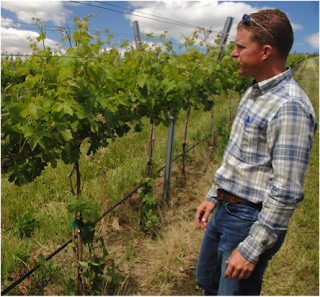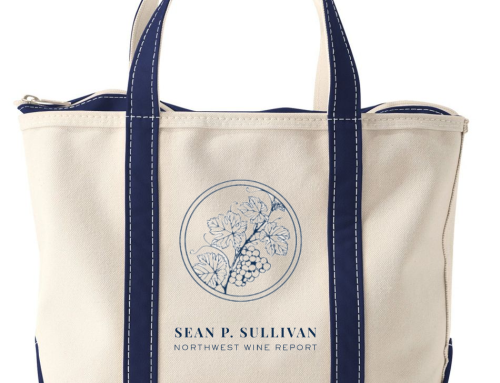Saving one of the best for last. What follows is a Focus Report on FIGGINS. Download a .pdf version of this report here. Read previous Focus Reports here.
Figgins comes from one of the first families of Washington wine. In 1974, Chris’ father Gary Figgins was working as a machinist at the Continental Can Company when he decided to plant an acre of Cabernet Sauvignon by the family home in Walla Walla. In 1977, he and his wife, Nancy, founded Leonetti Cellar.

Leonetti Cellar produced its first vintage in 1978. The 1978 Cabernet was entered into a competition and judged by Wine & Spirits magazine “the best Cabernet produced in America.” This was the first of a long string of accolades, with Leonetti now having too many high scores and Top 100 rankings to mention.
A Father’s Dream
One day as he was thinking about a career in architecture, he had an epiphany. “If I do this, I’m going to spend my life under fluorescent lights by a computer,” he thought. Figgins, who had worked on farms, fields, and vineyards growing up, had a different idea. “I wanted to grow stuff,” he said.
Figgins made a phone call to his father. “I said to him, ‘What if I change my major to horticulture and we plant our own vineyards?’” he recalls. His father’s response was supportive but neutral, wanting to let his child make his own decision. His mother later told him that Gary Figgins cried that night when he got off the phone. It would be one of the happiest days of his life.
Chris Figgins’ first full vintage at Leonetti was 1996. Since that time the winery has transitioned to using exclusively estate fruit from the Walla Walla Valley for its wines. By 2001, Chris Figgins had assumed head winemaking responsibilities from his father.
A Son’s Dream
Though he had fulfilled his wish to move the Leonetti wines to estate vineyards, Chris Figgins had another dream – to make one wine from a single, estate vineyard. As a terroirist, the idea of 
At first, Figgins thought about trying to make a single vineyard wine under the Leonetti label. The winery had made single vineyard wines from Seven Hills Vineyard in the past. However, Figgins felt that it didn’t quite fit with what Leonetti was currently doing. Rather, he felt the project would have to be its own winery.
Figgins says it took his parents some time to come around to the idea of starting a separate winery dedicated to a single vineyard, with the concern being that it might distract from the Leonetti brand. But the concern was about more than the brand. “I am their retirement plan!” Figgins says laughing. Once his parents’ approval was in place, there was, however, another pressing matter – finding the right site.
A Special Site
Figgins first came upon what is now FIGGINS Vineyard while looking for property to build a house. He got a call from a family friend who was selling off parcels of land after the passing of his father. Intriguingly, the land was a half-mile from Leonetti’s Mill Creek Upland Vineyard, at a slightly higher elevation.
The day before Thanksgiving in 2003, Chris met with his friend, who threw out a price. They shook on it. Figgins closed on the property within a week. Figgins says of the site, “When we saw this piece of land, we knew it was special.”
While the decision to purchase the land was made quickly, the process of establishing the vineyard was long and laborious. First Figgins had to purchase water rights to another piece of land and transfer it to the site, taking several years. Then the site had to be prepared for planting.
The FIGGINS Vineyard property was originally a wheat field. Figgins started by ripping the land four feet deep. He created a series of compost teas, which he brewed at Leonetti, to help restore the soil from years of wheat farming. Next came planting the vineyard.
To do this, Figgins used multiple different spacings depending on the location and varietal, angling the vineyard slightly southwest. A double cordon system was used to increase plant density, shoot density, and plant population. Figgins also used the system to open up light and airflow.
“I’m a big proponent of balance in terms of spacing,” Figgins says. “You want it to be as tight as you can get and still be in balance and no tighter.”

The rows of the vineyard have limestone posts brought in from Kansas, a tribute to the Figgins family’s roots there. There is a well house made of stone that came from a root cellar in Milton-Freewater. The building bears a plaque with a quote from Byron, “Till taught by pain, men know not water’s worth.” Figgins explains the meaning by quoting Mark Twain saying, “Whiskey is for drinking; water is for fighting over.”
Establishing Biodiversity
A variety of species were planted throughout the vineyard, with native plants, such as lupin and native roses, used as much as possible. Walking through the vineyard, it is resplendent with life. There are butterflies, flowers, bushes, and honeybees literally everywhere.
“We sacrificed rows and acreage to build in biodiversity,” Figgins explains. He says the goal is to keep the plants in the vineyard in a continual bloom. With pollen in the vineyard, predatory pests stay all year long.
32 acres are currently planted to Cabernet, Merlot, and Petit Verdot. The vines were planted on their own rootstock, with the first plantings in 2005. Figgins decided not to use the vineyard’s initial fruit in 2007. “Knowing I was going for a high end project, it wasn’t time,” he says, adding, “You can make great wine on young vines. It’s just more difficult.”
Due to the vineyard’s high elevation, 1,500 to 1,700 feet, it sees a 35-40 degree diurnal shift. Figgins says that, like clockwork, cold air flows down the canyons of Mill Creek each night. This helps preserve the acidity in the grapes. The vineyard has deep silt loam and receives approximately twenty-two inches of rainfall annually.
The Inaugural Release
The 2008 wine saw 22 months in barrel and one year in bottle prior to release. Figgins made approximately 900 cases in 2008 with the intent of growing the winery slowly to about 4,000 over the next decade or so.
The inaugural FIGGINS Estate Red Wine is arresting, full of earth, floral notes, and fruit aromas and flavors. The wine is simultaneously rich, structured, and light on its feet. As with the recent releases at Leonetti Cellar, this wine is very much about elegance and vineyard expression and is far from a fruit and barrel wine. It is among the more compelling wines to be released in 2011.
As the industry continues to grow and expand at an incredible rate, it is impossible not to reflect on the enormous impact the Figgins family has had on the Washington wine industry over the last thirty-five years. Tasting this wine, it seems clear that the family has only begun to leave its mark.
FIGGINS Estate Red Wine Walla Walla Valley 2008 $85
Rating: ** (Exceptional) An almost endless list of aromas including scorched earth, red and black fruit, bittersweet chocolate, floral notes, and licorice. Wound up tightly initially, the palate is dense and rich with fruit and earth flavors while remaining incredibly elegant. A seemingly endless finish. Cabernet Sauvignon, Petit Verdot, and Merlot. Aged 22 months in French oak (70% new). 14.3% alcohol.







Leonetti is always a favorite in our house. And the 08 Figgins is quite aromatic, really beautiful despite its youth. Can't wait to taste it again in a couple of years. Enjoyed the article. The torch is transitioning from one generation to the next and the quality is moving forward to a higher plane. Can't wait for future Figgins vintages but instead of drinking all of them like I've done on Leonetti, I'll lay a few bottles of each aside for a vertical tasting when I turn 70. Join me. It'll be fun.
Sean – congratulations on another terrific Focus article. They are rare in the world of wine literature and are very informative, but better still, very interesting! Please keep them coming. I have been a Leonetti fan for years and think their wines are getting better and better. (They still do not work well with round bottom decanters and back porches… :) ) The Figgins brand has not yet made it up here to Canada, but hopefully that will some day change. I would love to try one.
Best wishes in 2012!
Sean: Loved the article. But then again, I'm a Figgins, too. Coming up from Tucson to Pasco/Walla Walla in August. Do you have a suggested list of wineries to visit? Our wine club in Tucson, Old Pueblo wine club has 400 members and meets monthly. Always a great turn out when we sample wines of the Northwest. Thanx in advance.
PS. I was able to snag 6 bottles of the new Figgins release. Can't wait.
keith Figgins
[email protected]
Hi Keith, thanks for the message. I'll email you some suggestions.